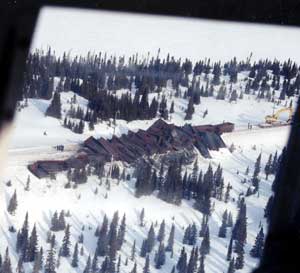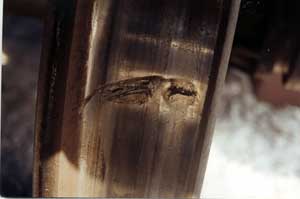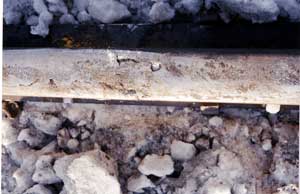Main track derailment
Quebec North Shore and Labrador Railway
Train No. PH 187
Mile 139.33, Wacouna Subdivision
Éric, Quebec
The Transportation Safety Board of Canada (TSB) investigated this occurrence for the purpose of advancing transportation safety. It is not the function of the Board to assign fault or determine civil or criminal liability. This report is not created for use in the context of legal, disciplinary or other proceedings. See Ownership and use of content. Masculine pronouns and position titles may be used to signify all genders to comply with the Canadian Transportation Accident Investigation and Safety Board Act (S.C. 1989, c. 3).
Summary
At approximately 1220 eastern standard time on 18 March 2002, 40 cars of Quebec North Shore and Labrador Railway (QNS&L) train No. PH 187, an ore unit train travelling south to Sept-Îles, Quebec, derailed at Mile 139.33 of the Wacouna Subdivision, near Éric, Quebec. As a result of the derailment, 33 cars were destroyed and 7 cars were damaged. About 300 metres of track was damaged. There were no injuries and no permanent environmental damage.
Ce rapport est également disponible en français.
Factual information
On 18 March 2002, the train departed Labrador City, Newfoundland and Labrador, with 2 locomotives and 160 gondola cars loaded with iron ore. It was about 5740 feet long and weighed approximately 20 300 tons. The crew consisted of a locomotive engineer who was qualified for the position and met the rest and fitness requirements.
At Mile 139.33, the train experienced an undesired brake application. The locomotive engineer followed the emergency procedures and determined that 40 cars had derailed (25th to 64th). Data from the lead locomotive event recorder indicated that the train was travelling at 34.3 mph, that the throttle had been moved gradually from the No. 7 position to neutral, that dynamic braking for the locomotives had been lightly applied, and that the undesired emergency brake application was train-initiated.
The Wacouna Subdivision extends 225 miles from Sept-Îles, Quebec, to Emeril Junction, Newfoundland and Labrador. Train movements are governed by the Centralized Traffic Control System rules pursuant to the Canadian Rail Operating Rules (CROR), and are supervised by a QNS&L rail traffic controller in Sept-Îles. The maximum permissible speed in the subdivision is 35 mph for loaded ore trains, 40 mph for empty ore trains and 50 mph for passenger trains.
The derailed cars were lying accordion style and piled up on top of each other, forming a heap of scrap and iron ore on the right-of-way (see Photo 1). Thirty-three cars were destroyed and seven cars were seriously damaged. About 300 metres of track was damaged. The weather was clear and the temperature was -12°C.
An examination of the cars revealed that the wheels on the east side of the cars preceding the 25th car (17th to 24th cars) had a mark across the wheel tread (see Photo 2). No other mechanical defects were observed on the cars.
The track consists primarily of 132-pound continuous welded rail (CWR) that was manufactured and laid in 1980. There are 3200 hardwood ties per mile of track. Double-shouldered tie plates are fastened with four spikes per tie. In the derailment area, the ties were in good condition. The maximum authorized weight of the cars is 286 000 pounds. The accumulated tonnage on the track since it was laid is 450 million tons.
The track is Class 3 according to Transport Canada's Railway Track Safety Rules, meaning that the track geometry must be verified twice yearly by the track geometry car while continuous testing of internal rail flaws must be done once a year.
In the Wacouna Subdivision, track geometry is verified six times a year by the track geometry car, and rail flaw detection testing is done about 10 times a year. The last rail flaw detection test was done on 06 March 2002 and no internal rail flaws were found in the accident area.
During the special visual inspections done between 05 February 2002 and the date of the accident to identify external rail defects, about 40 crushed heads were found between Mile 130 and Mile 150. These defects were categorized according to severity, with "priority 1" being used for the most urgent work. Corrective measures had been planned to correct the defects according to priority, with the repairs for "priority 1" defects to be carried out within one month of being identified. No additional rail defects were observed in the last bi-weekly visual inspection conducted on 15 March 2002 by a supervisor on a hi-rail car.
At approximately Mile 139.33, where the destruction of the track started, the rail had a crushed head (see Photo 3). This surface defect was noted in the inspection of 05 February 2002 and was categorized as "priority 1." A few feet south of this defect, the rail was broken under the last derailed car. Four pieces of broken rail, two pieces of rail head and two pieces of rail base were recovered and sent to the TSB Engineering Laboratory for analysis. There were no wheel flange marks or marks from dragging parts to the north of where the rail was broken. Wheel flange marks were visible east of the track, leading to the first derailed car.
Examination of the rail by the TSB Engineering Laboratory (report No. LP 030/02) indicated that wear of the rail was minimal. The rail head surface showed signs of light shelling on the interior side of the head. Tests on rail specimens showed that the rail had a maximum tensile strength of 171 ksi.Footnote 1 The hardness of the rail head surface approached a Rockwell C hardness of 42 (or Brinell 393) in the first 0.7 mm; a surface hardness of this magnitude is normal and is due to strain hardening of the surface layer of the metal.
Analysis
Before the point where the destruction of the track started, the track and roadbed showed no signs that a wheel had climbed the rail or that an equipment failure, such as a broken wheel or axle, had caused the derailment. Moreover, the event recorder did not indicate any abnormal manoeuvres in the train's operation. The analysis will focus on the fractured rail.
The laboratory tests revealed that there were no pre-existing cracks in the rail specimens and that the break occurred quickly, and everything indicates that the rail broke suddenly as the train passed. The fracture pattern observed on the rail specimens indicates that a fracture started at the rail head surface and coincided with the edge of the creep on the rail that acted like a stress raiser. The high tensile strength and relatively high hardness measured on the rail specimens are properties indicating a material that is sensitive to the initiation and development of internal flaws; thus, the rail was sensitive to impacts from the wheels, especially in cold weather.
The wheel flange marks visible on the ties at the point where the destruction of the track started continued up to the first derailed car. In addition, the mark on the wheels on the east side of the cars preceding the derailed cars confirmed that the east rail broke under the 17th car as train PH 187 passed.
The number of rail loading and unloading cycles increases with the accumulated tonnage that has travelled on the rails. When this tonnage becomes high (more than 400 to 450 million tons as is the case in this occurrence), fatigue resistance is reduced, resulting in increased internal and external rail defects and rail failures and requiring continuous rail flaw detection tests and much more frequent special visual inspections.
QNS&L carries out about 10 continuous rail flaw detections per year, and the last one was done some 12 days before the derailment. However, rail failures can occur even when no internal flaws exist. They can be caused by one factor or a combination of factors, including stress raisers, wheel impacts caused by wheel defects or faulty rail surfaces, low temperatures and residual tensile stress.
In addition, special visual inspections had been conducted to identify rail defects. The defects had been assessed according to their severity and repair work had been planned accordingly. However, the relatively high number of crushed heads - an average of about two defects per mile of track between Mile 130 and Mile 150 - did not allow the repair teams to complete the repair work as planned.
Findings
Findings as to causes and contributing factors
- The rail broke suddenly under the 17th car as the train passed, resulting in the derailment of the train.
Findings as to risk
- The relatively high number of crushed heads - an average of about two defects per mile of track between Mile 130 and Mile 150 - did not allow the repair teams to complete the repair work as planned.
- Rail failures can occur even when no internal flaws exist. They can be caused by one factor or a combination of factors, including stress raisers, wheel impacts caused by wheel defects or faulty rail surfaces, low temperatures and residual tensile stress.
- When the accumulated tonnage that has travelled on the rails becomes high, fatigue resistance is reduced, resulting in increased internal and external rail defects and rail failures and requiring continuous rail flaw detection tests and much more frequent special visual inspections.
Safety action
QNS&L implemented a system to follow up on the priorities and to control risks in order to correct the most priority defects. Criteria acceptable for rail defects were tightened; for example, the acceptable limit for crushed heads went from 13 mm to 7 mm.
The company will develop an action plan and a preventive maintenance program to correct surface defects by controlling the wheel-to-rail interface dynamics. Under this initiative, 45 new rail lubricators will be installed and put in service, a wheel reshaping plan will be put in place, a wheel-shaping tower will be purchased and the number of grinded rail will be doubled (from 800 to 1600 runs per mile each year).
This report concludes the Transportation Safety Board's investigation into this occurrence. Consequently, the Board authorized the release of this report on .


